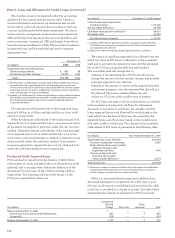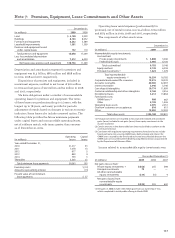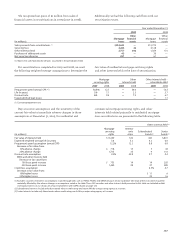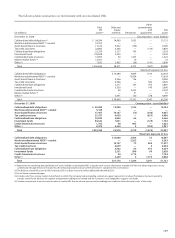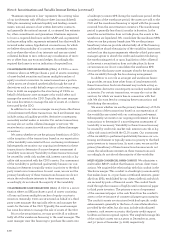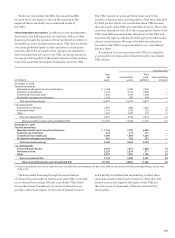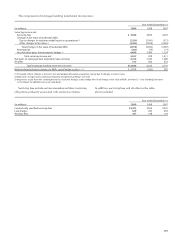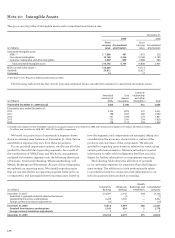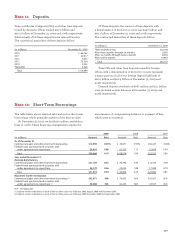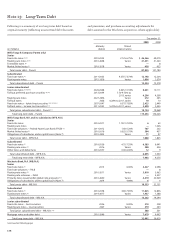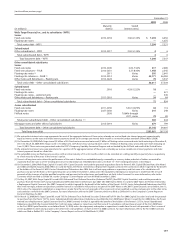Wells Fargo 2009 Annual Report Download - page 134
Download and view the complete annual report
Please find page 134 of the 2009 Wells Fargo annual report below. You can navigate through the pages in the report by either clicking on the pages listed below, or by using the keyword search tool below to find specific information within the annual report.
For example, we had investments in asset-backed securi-
ties that were collateralized by auto leases or loans and cash
reserves. These fixed-rate securities are underwritten by us
and have been structured as single-tranche, fully amortizing,
unrated bonds that are equivalent to investment-grade securities
due to their significant overcollateralization. The securities
are issued by SPEs that have been formed by third party auto
financing institutions primarily because they require a source
of liquidity to fund ongoing vehicle sales operations.
TAX CREDIT STRUCTURES We co-sponsor and make investments
in affordable housing and sustainable energy projects that
are designed to generate a return primarily through the
realization of federal tax credits. In some instances, our
investments in these structures may require that we fund
future capital commitments at the discretion of the project
sponsors. While the size of our investment in a single entity
may at times exceed 50% of the outstanding equity interests,
we do not consolidate these structures due to performance
guarantees provided by the project sponsors giving them
a majority of the variability.
INVESTMENT FUNDS At December 31, 2009, we had invest-
ments of $1.3 billion and lending arrangements of $20 million
with certain funds managed by one of our majority owned
subsidiaries compared with investments of $2.1 billion and
lending arrangements of $349 million at December 31, 2008.
In addition, we also provide a default protection agreement to
a third party lender to one of these funds. Our involvements
in these funds are either senior or of equal priority to third
party investors. We do not consolidate the investment funds
because we do not absorb the majority of the expected future
variability associated with the funds’ assets, including vari-
ability associated with credit, interest rate and liquidity risks.
We are also a passive investor in various investment
funds that invest directly in private equity and mezzanine
securities as well as funds sponsored by select private equity
and venture capital groups. We also invest in hedge funds
on behalf of clients. In these transactions, we use various
derivative contracts that are designed to provide our clients
with the returns of the underlying hedge fund investments.
We do not consolidate these funds because we do not hold
a majority of the subordinate interests in these funds.
MONEY MARKET FUNDS In 2008 we entered into a capital
support agreement for up to $130 million related to an invest-
ment in a structured investment vehicle (SIV) held by AAA-
rated money market funds we sponsor in order to maintain
a AAA credit rating and a NAV of $1.00 for the funds. In third
quarter 2008, we fulfilled our obligation under this agreement
by purchasing the SIV investment from the funds. In third
quarter 2009, we purchased additional SIV investments from
the AAA-rated money market funds. At December 31, 2009,
we had no outstanding support agreements. We recorded
a loss of $27 million in 2009 in connection with support pro-
vided to our money market/collective funds. At December 31,
2009, the SIV investments were recorded as debt securities
in our securities available-for-sale portfolio. We do not consol-
idate these funds because we do not absorb the majority of
the expected future variability associated with the fund’s
assets. We are generally not responsible for investment losses
incurred by funds we sponsor, and we do not have a contrac-
tual or implicit obligation to indemnify such losses or provide
additional support to the funds. While we previously elected
to enter into capital support agreements for the funds, we are
not obligated and may elect not to provide support to these
funds or other funds we sponsor in the future.
CREDIT-LINKED NOTE STRUCTURES We enter into credit-linked
note structures for two separate purposes. First and primarily,
we structure transactions for clients designed to provide
investors with specified returns based on the returns of an
underlying security, loan or index. Second, in certain situations,
we also use credit-linked note structures to reduce risk-
weighted assets for determining regulatory capital ratios
by structuring similar transactions that are indexed to the
returns of a pool of underlying loans that we own. These
transactions reduce our risk-weighted assets because they
transfer a portion of the credit risk in the indexed pool of
loans to the holders of the credit-linked notes. Both of these
types of transactions result in the issuance of credit-linked
notes and typically involve a bankruptcy remote SPE that
synthetically obtains exposure to the underlying loans
through a derivative instrument such as a written credit
default swap or total return swap. The SPE issues notes to
investors based on the referenced underlying securities or
loans. Proceeds received from the issuance of these notes are
usually invested in investment grade financial assets. We
are typically the derivative counterparty to these transactions
and administrator responsible for investing the note proceeds.
We do not consolidate these SPEs because we typically do
not hold any of the notes that they issue.
OTHER TRANSACTIONS WITH VIES In August 2008, Wachovia
reached an agreement to purchase at par auction rate
securities (ARS) that were sold to third party investors by two
of its subsidiaries. ARS are debt instruments with long-term
maturities, but which reprice more frequently. Certain of
these securities were issued by VIEs. At December 31, 2009, we
held in our securities available-for-sale portfolio $3.2 billion
of ARS issued by VIEs that we redeemed pursuant to this
agreement, compared with $3.7 billion at December 31, 2008.
At December 31, 2008, we had a liability in our balance sheet
of $91 million for additional losses on anticipated future
redemptions of ARS issued by VIEs. We did not have a liability
related to this event at December 31, 2009, since all remaining
ARS issued by VIEs subject to the agreement were redeemed.
On November 18, 2009, we reached agreements to pur-
chase additional ARS from eligible investors who bought
ARS through one of three of our broker-dealer subsidiaries.
At December 31, 2009, we had a liability in our balance sheet
of $261 million for losses on anticipated future redemptions
of ARS associated with these agreements. As of December 31,
2009, we had not redeemed a substantial amount of these
securities. Were we to redeem all ARS issued by VIEs that are
subject to the agreement, our estimated maximum exposure
to loss would be $1.6 billion; however, certain of these securi-
ties may be repaid in full by the issuer prior to redemption.
Note 8: Securitizations and Variable Interest Entities (continued)


